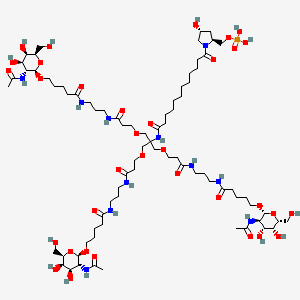



1. Aln-pcs
2. Aln-pcssc
3. Inclisiran
1. Aln-pcssc
2. Cemdisiran, Terminal Sugar Modification-
3. Cqq59545bv
4. Inclisiran, Terminal Sugar Modification-
5. 1436858-07-9
6. Inclisiran
7. Unii-cqq59545bv
8. Glxc-26019
9. Hy-145720
10. Hy-147077
11. 1639324-58-5
| Molecular Weight | 1807.0 g/mol |
|---|---|
| Molecular Formula | C78H140N11O34P |
| XLogP3 | -8 |
| Hydrogen Bond Donor Count | 22 |
| Hydrogen Bond Acceptor Count | 34 |
| Rotatable Bond Count | 66 |
| Exact Mass | 1805.9301776 g/mol |
| Monoisotopic Mass | 1805.9301776 g/mol |
| Topological Polar Surface Area | 663 Ų |
| Heavy Atom Count | 124 |
| Formal Charge | 0 |
| Complexity | 2950 |
| Isotope Atom Count | 0 |
| Defined Atom Stereocenter Count | 17 |
| Undefined Atom Stereocenter Count | 0 |
| Defined Bond Stereocenter Count | 0 |
| Undefined Bond Stereocenter Count | 0 |
| Covalently Bonded Unit Count | 1 |
Inclisiran is indicated for the treatment of primary hypercholesterolemia (heterozygous familial and non-familial) or mixed dyslipidemia in adults, as an adjunct to diet. It can be used in combination with a statin or statin with other lipid-lowering therapies in patients who cannot reach LDL-C goals with the maximum tolerated dose of a statin. In patients who cannot tolerate statins or in whom a statin is contraindicated, inclisiran can be used as monotherapy or in combination with other lipid-lowering therapies.
Leqvio is indicated in adults with primary hypercholesterolaemia (heterozygous familial and non-familial) or mixed dyslipidaemia, as an adjunct to diet:
- in combination with a statin or statin with other lipid-lowering therapies in patients unable to reach LDL-C goals with the maximum tolerated dose of a statin, or
- alone or in combination with other lipid-lowering therapies in patients who are statin-intolerant, or for whom a statin is contraindicated.
Inclisiran is a long-acting small interfering RNA (siRNA) that works to lower plasma LDL-cholesterol (LDL-C) levels. In clinical trials, the reduction of LDL-C levels was observed within 14 days post-dose: mean reductions of LDL-C by 48-51% were observed 30 to 60 days post-dose and reduction of LDL-C levels by 53% persisted after 180 days post-dose. In healthy volunteers, inclisiran reduced PCSK9 levels by 70-80% and LDL-C levels by 27-60%. In a clinical trial consisting of subjects with atherosclerotic cardiovascular disease with or without diabetes, inclisiran reduced LDL-C levels by 28-52%. The long-term effect of inclisiran on cardiovascular outcomes has not yet been elucidated, although reductions in the levels of LDL-C have been associated with a reduction of cardiovascular risk.
C10AX
C - Cardiovascular system
C10 - Lipid modifying agents
C10A - Lipid modifying agents, plain
C10AX - Other lipid modifying agents
C10AX16 - Inclisiran
Absorption
After uptake into the liver, inclisiran has a long duration of action. Following subcutaneous administration of a single dose ranging from 24 mg to 756 mg, systemic exposure to inclisiran increased in a dose-proportional manner. The mean Cmax was 509 ng/mL and the Tmax was approximately 4 hours after the administration of 284 mg inclisiran. The mean AUC0-inf was 7980 ng x h/mL. After 48 hours of dosing, drug plasma concentrations were undetectable. Pharmacokinetic findings following a single-dose administration of inclisiran were comparable to inclisiran administered in multiple doses.
Route of Elimination
About 16% of the total dose of inclisiran is cleared through the kidney.
Volume of Distribution
The apparent volume of distribution was approximately 500 L following subcutaneous administration of a single 284 mg dose of inclisiran in healthy adults. According to non-clinical studies, inclisiran is highly taken up by the liver.
Clearance
There is limited information on the clearance rate of inclisiran.
Inclisiran is metabolized by nucleases to form smaller nucleotides of varying lengths. It is not anticipated to be a substrate for cytochrome P450 enzymes.
The terminal elimination half-life of inclisiran is approximately 9 hours.
Low-density lipoprotein (LDL) receptors expressed on hepatocytes are responsible for the removal of circulating LDL-C from plasma via receptor-mediated endocytosis. Proprotein convertase subtilisin-kexin type 9 (PCSK9) is a serine protease that is mainly produced by hepatocytes. It binds to LDL receptors and targets them for lysosomal degradation, thereby reducing the levels of LDL receptors, attenuating the recycling of LDL receptors, and elevating the levels of circulating plasma LDL-C. Inclisiran is conjugated to triantennary N-acetylgalactosamine carbohydrates, which can bind to asialoglycoprotein receptors expressed in the liver. Binding to asialoglycoprotein receptors facilitates the uptake of inclisiran into the hepatocytes. Once inside the hepatocyte, inclisiran binds to the RNA-induced silencing complex (RISC), which is a ribonucleoprotein complex that serves as a template for recognizing the target complementary mRNA, activate RNAse, and cleave the target mRNA. Inclisiran incorporated into the RISC allows the drug to cleave PCSK9 mRNA and prevent PCSK9 translation, thus decreasing hepatic production of PCSK9. Less PCSK9 protein available allows more LDL receptors to be recycled to the hepatic membrane for circulating LDL-C uptake.
